You can play background sounds on your iPhone to help you focus, stay calm, or fall asleep, giving you a personal sound machine wherever you go. Even better, there's a way to set each of your apps to play one of Apple's six ambient soundscapes automatically. When you open the app, its assigned sound plays, then it stops when you exit or switch to another app.
While iOS 15 and iOS 16 include "Per-App Settings," you won't find any background sounds in there. Instead, you'll need to create an automation in Shortcuts, and there are multiple ways you can go about it. None are perfect solutions, so they are more like "hacks" to use until something better comes along.
Create a New Automation
First, open up Shortcuts, tap the "Automation" tab, and hit the blue "Create Personal Automation" button. If you already have one or more automations saved, tap the plus (+) icon in the top right to find the "Create Personal Automation" button.




Choose the Apps for the Sound
Select "App" from the list, tap "Choose," and highlight the app or apps in question. There's no need to create an automation for each app itself. Instead, you're making one for each background sound and volume pairing, so select all the apps you want for the sound and volume level you'd like to set up first. You can edit these later to add more apps, subtract apps, or change volume levels.
Hit "Done" when finished checking your apps.






Choose the Right Shortcut
As I said, there are multiple ways to build a shortcut that plays a background sound when you open an app and stops it when you exit. I'll give you two options using "Automations" below and one using a regular shortcut, but if you know of a better way, let us know!
Note: when setting "Background Sound," you have six choices:
- Balanced Noise
- Bright Noise
- Dark Noise
- Ocean
- Rain
- Stream
To help you save time, all the options below include a shortcut link you can add to your Shortcuts library. That way, you don't have to perform every step. For the automations, just add the "Run Shortcut" action and choose the downloaded shortcut in lieu of the other actions.
Toggle the Background Sound
The easiest way is to toggle "Background Sounds" on and off whenever the chosen app is opened and closed. It works like a charm, as long as you're not already playing any background sounds. If you are, when you open the app, it will toggle the sound off and turn it on when you exit. To avoid that, try Option 2 below.
Instead of building the whole automation out, you can install our Toggle Background Sound shortcut, then choose the sound and the volume levels during the setup. Then, just add the "Run Shortcut" action and choose the Toggle Background Sound shortcut in lieu of the other actions (steps 3–11 below).
- Select both "Is Opened" and "Is Closed" on the New Animation window.
- Tap "Next."
- Add "Set Background Sounds" on the Actions window.
- Tap "Turn" in that action, and choose "Toggle" instead.
- Add another action for "Change Background Sound."
- Tap the current background sound in that action if it's not the one you want, and choose a different one.
- Add another action for "Set Background Sounds Volume." (This is optional.)
- Tap the current percentage for "Volume" in that action, and choose the volume level you want.
- Add another action for "Set Background Sounds Volume." (This is optional.)
- Tap "Volume" and change it to "Volume When Media Is Playing."
- Tap the current percentage for that, and choose the volume level you want.
- Hit "Next" in the top right.
- Toggle off "Ask Before Running" and "Notify When Run."
- Hit "Done" to save.
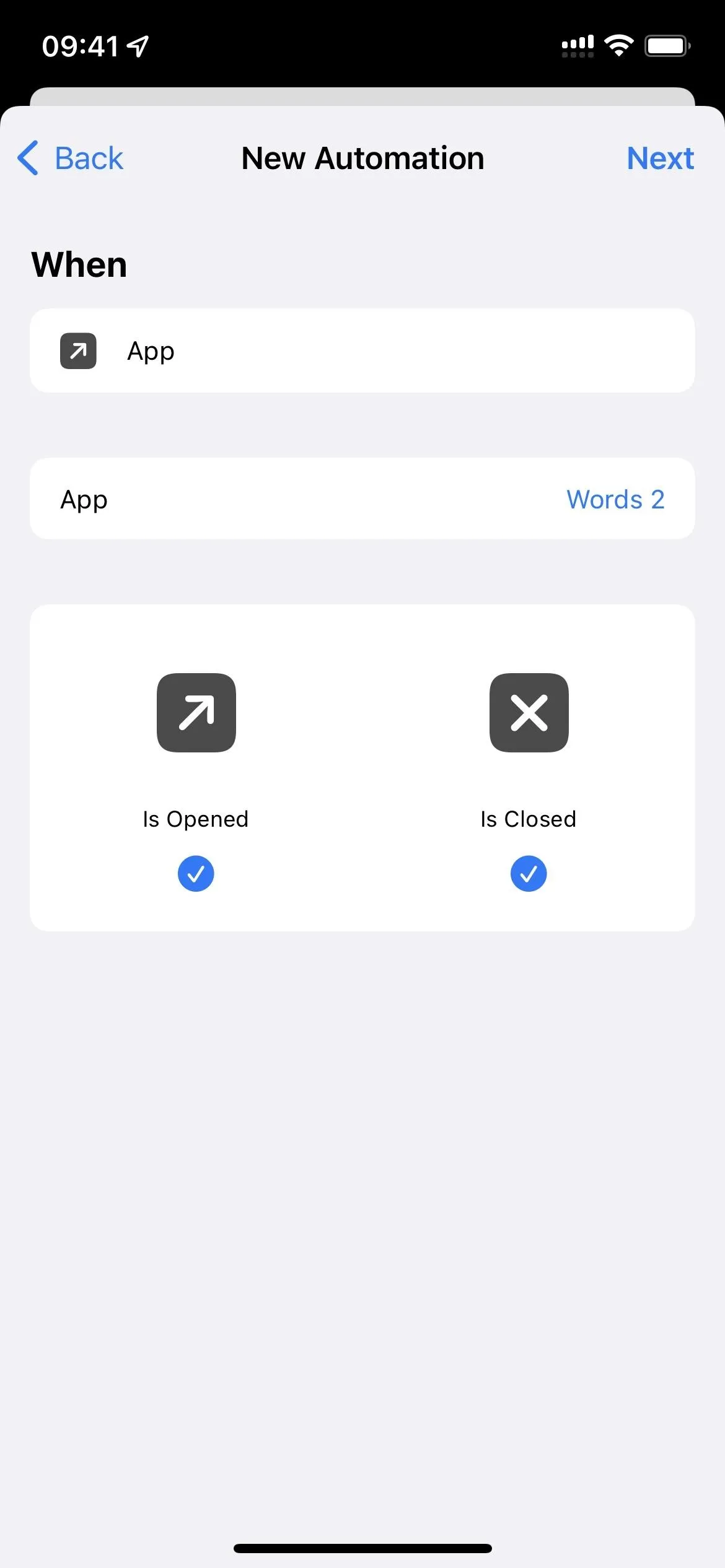
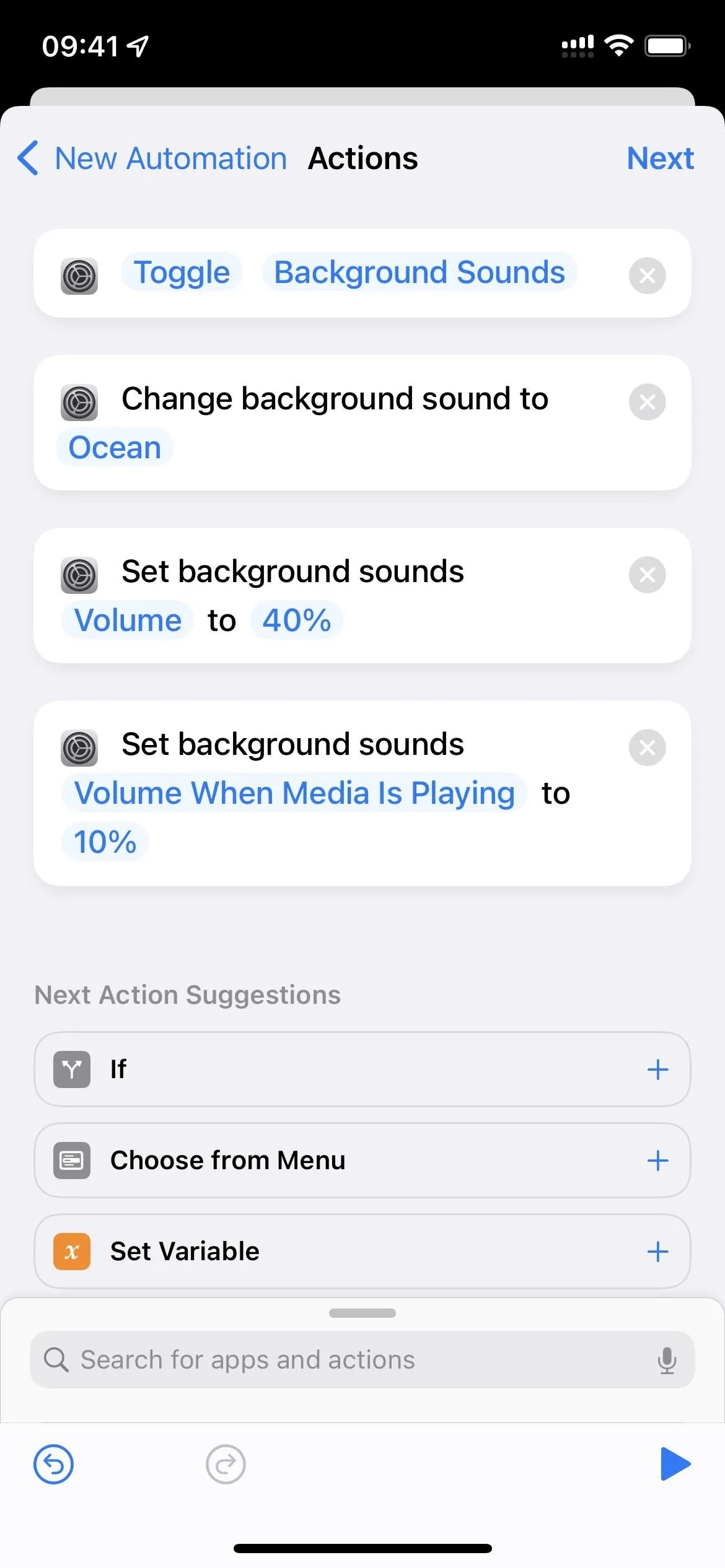




Turn the Background Sound On or Off
This way requires two separate automations — one to trigger your background sound when the app opens and another to turn off background sounds when the app closes. It's by far the best option on this list, only it takes more time to set up than Option 1.
Instead of building the whole "Is Opened" automation, you can install our Turn On Background Sound shortcut, then choose the sound and the volume levels during the setup. Then, just add the "Run Shortcut" action and choose the Toggle Background Sound shortcut in lieu of the other actions (steps 3–11 below).
- Select "Is Opened" on the New Animation window.
- Tap "Next."
- Add "Set Background Sounds" on the Actions window.
- Make sure the action says "Turn Background Sounds On," which is the default.
- Add another action for "Change Background Sound."
- Tap the current background sound in that action if it's not the one you want, and choose a different one.
- Add another action for "Set Background Sounds Volume." (This is optional.)
- Tap the current percentage for "Volume" in that action, and choose the volume level you want.
- Add another action for "Set Background Sounds Volume." (This is optional.)
- Tap "Volume" and change it to "Volume When Media Is Playing."
- Tap the current percentage for that, and choose the volume level you want.
- Hit "Next" in the top right.
- Toggle off "Ask Before Running" and "Notify When Run."
- Hit "Done" to save.

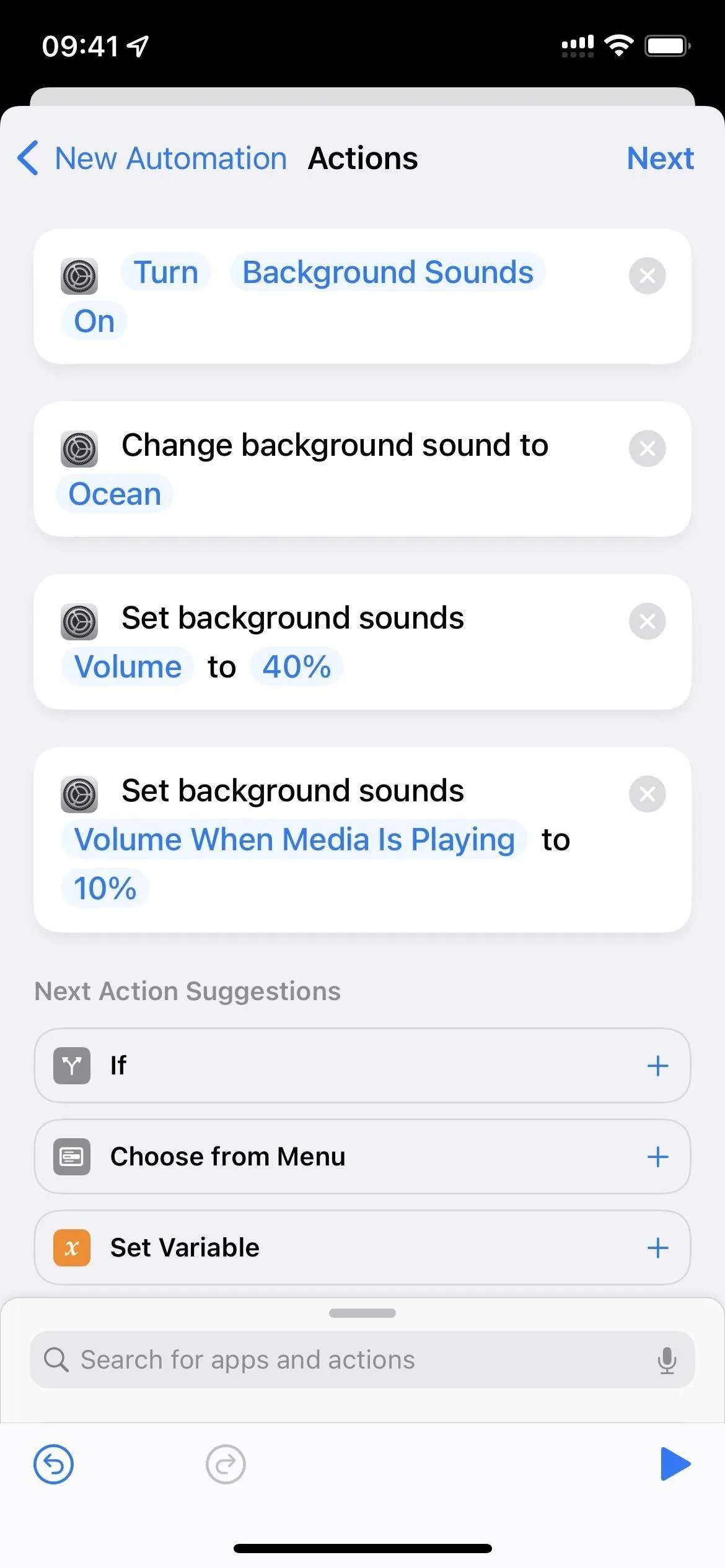
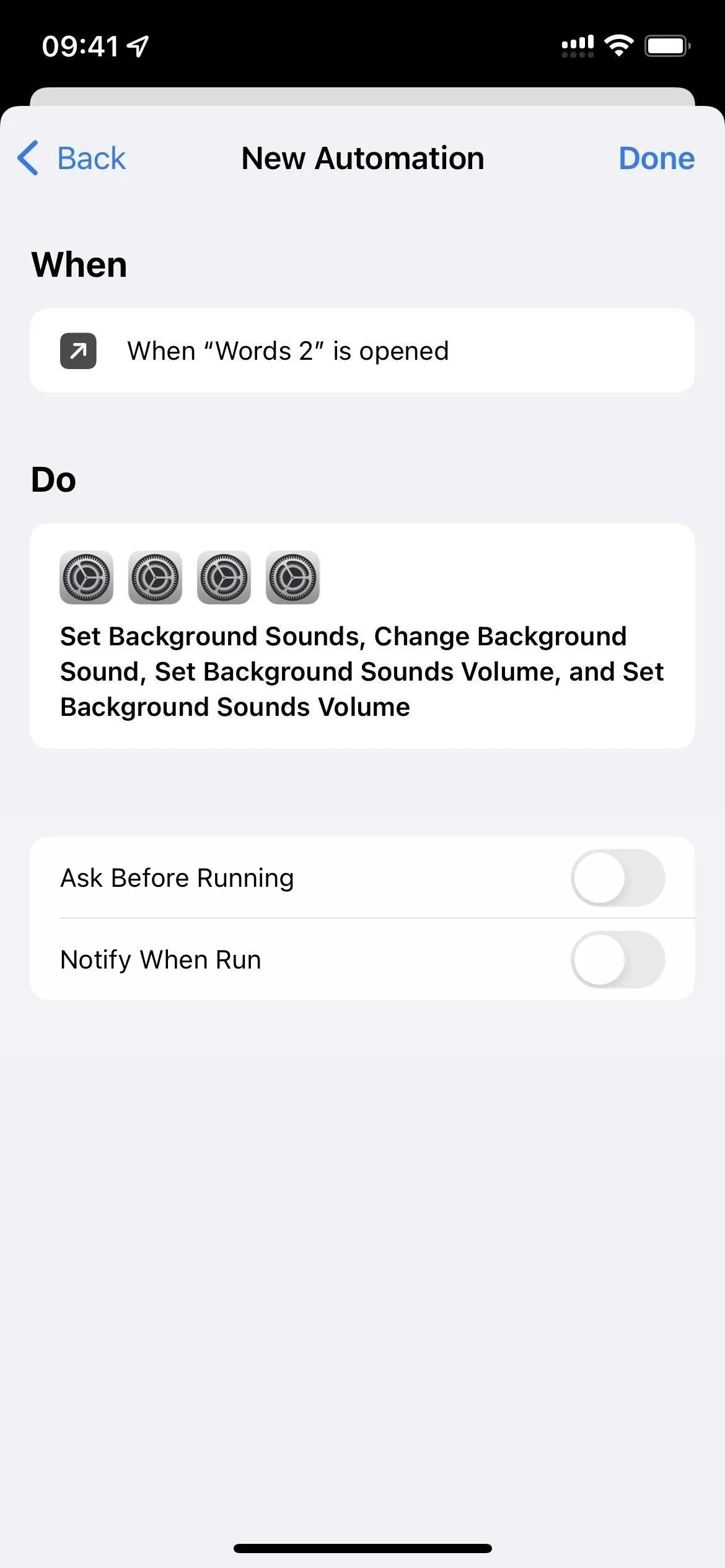



The automation to turn "Background Sounds" off is easier. If you don't mind manually turning off "Background Sounds" all the time, you could omit these "Is Closed" instructions.
Instead of building the whole "Is Closed" automation, you can install our Turn Off Background Sound shortcut. Then, just add the "Run Shortcut" action and choose the Toggle Background Sound shortcut in lieu of the other actions (steps 3–4 below).
- Select "Is Closed" on the New Animation window.
- Tap "Next."
- Add "Set Background Sounds" on the Actions window.
- Tap "On" to switch it "Off" so it says "Turn Background Sounds Off."
- Hit "Next" in the top right.
- Toggle off "Ask Before Running" and "Notify When Run."
- Hit "Done" to save.

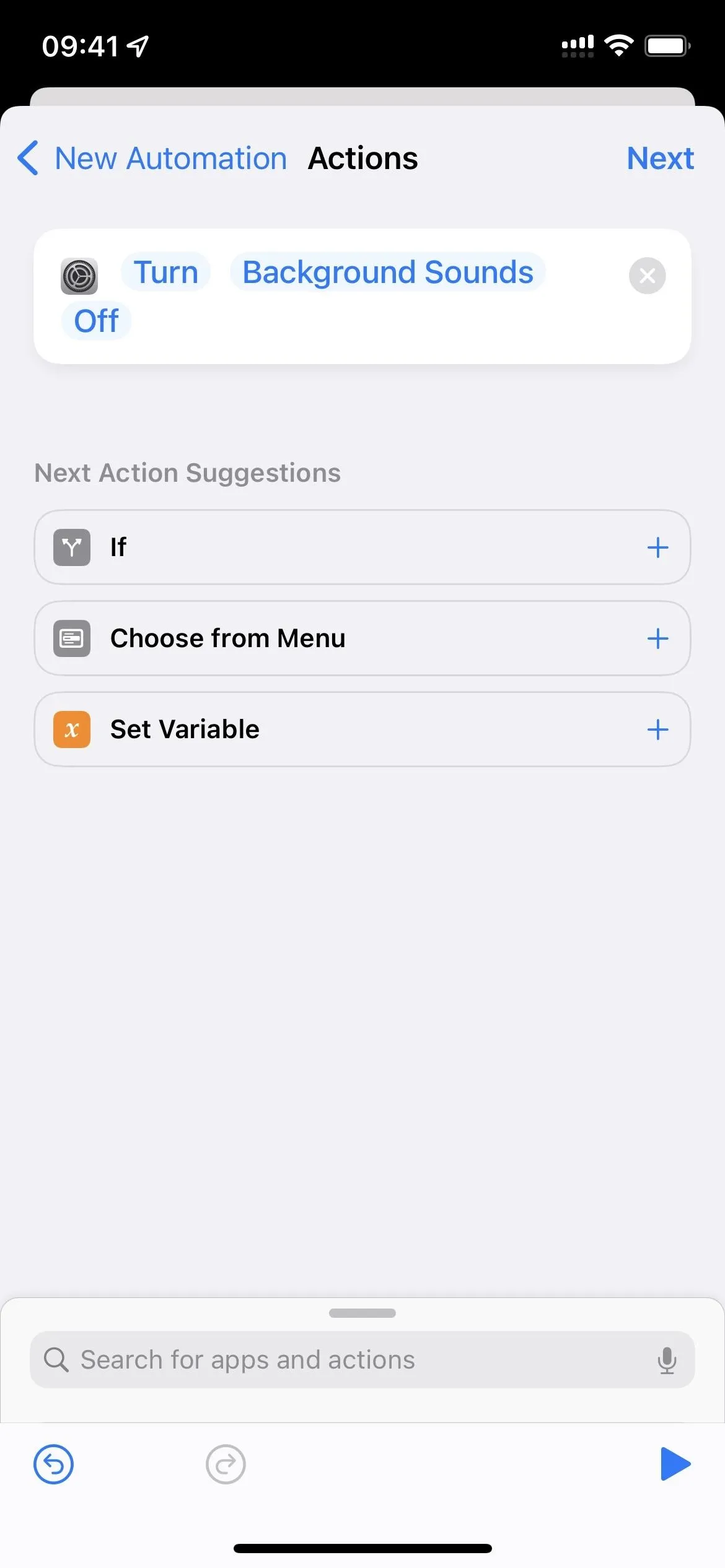




Create a Home Screen Shortcut
This option will only turn on "Background Sounds" to the sound and volume level you want whenever you open the shortcut from your Home Screen or via Siri.
There are multiple downsides. First, it will keep playing the sound when you exit the app. To fix that, you'd need to set up an "off" automation, as seen in Option 2 above. Second, you have to make a shortcut for every app you want to link to a background sound. And third, it will only work from the Home Screen or via Siri.
Instead of building the whole automation out, you can install our Background Sound Bookmark shortcut, then choose the app, sound, and volume levels during the setup. Then, just add the "Run Shortcut" action and choose the Toggle Background Sound shortcut in lieu of the other actions (steps 5–15 below).
- Ignore Steps 1–3 above, and go to "My Shortcuts" in the Shortcuts app.
- Start a new shortcut.
- Give it the name of the app you're linking.
- Add a custom app icon if you'd like. (This is optional.)
- Add the "Open App" action.
- Tap "App" on that action, and choose the app in question.
- Add "Set Background Sounds."
- Make sure the action says "Turn Background Sounds On," which is the default.
- Add another action for "Change Background Sound."
- Tap the current background sound in that action if it's not the one you want, and choose a different one.
- Add another action for "Set Background Sounds Volume." (This is optional.)
- Tap the current percentage for "Volume" in that action, and choose the volume level you want.
- Add another action for "Set Background Sounds Volume." (This is optional.)
- Tap "Volume" and change it to "Volume When Media Is Playing."
- Tap the current percentage for that, and choose the volume level you want.
- Hit the Settings button in the top right (iOS 15) or the information (i) button at the bottom (iOS 16), then "Add to Home Screen," and "Add." (You can add a custom app icon now if you didn't before and do want one.)
- Hit "Done," then the X button in the top right.






You could use apps like ToolBox Pro to develop a more advanced automation, but ToolBox Pro's "Is audio playing?" action can't distinguish between media and background sounds.
In a perfect world, Apple or Toolbox Pro would have an action for "Is Background Sounds Playing" or "Detect Background Sounds." With that, you could add an "if" statement to the beginning of Option 1 above that changes the background sound when a background sound is already playing. That way, it wouldn't toggle off "Background Sounds" if it's already on. Maybe one day.
Cover photo and screenshots by Justin Meyers/Gadget Hacks

























Comments
Be the first, drop a comment!